You are using an out of date browser. It may not display this or other websites correctly.
You should upgrade or use an alternative browser.
You should upgrade or use an alternative browser.
SpaceX Falcon 9 historic landing thread (1st landing attempt & most recent missions)
- Thread starter georgegassaway
- Start date

Help Support The Rocketry Forum:
This site may earn a commission from merchant affiliate
links, including eBay, Amazon, and others.
- Joined
- Jan 17, 2009
- Messages
- 5,204
- Reaction score
- 1,547
Indeed! So NOT a failure.
Launch = Successful.
Payload to ISS = Successful
Experiment to land safely = NOT successful.
Things learned, absolutely. They'll probably do it next time (which may be in 2-3 weeks). But the landing objective, not met this time.
From what i've been reading on NSF, and the video, it seems like it was angled about 45 degrees-ish when it hit the barge, with the engine section probably hitting the side (or that big metal container that was bashed in) and those holes in the side of the barge apparently indeed punched in by the legs.
Even if it had been able to make it to the middle of the deck, it could never have stopped that kind of horizontal motion. It does not have the fuel and throttling range to come in sideways, stop vertical descent, pitch the opposite way to cancel the horizontal vector, and then land (like when a helicopter "flares" for landing). The solution to that is not give it more fuel (it would mean robbing payload capability), mostly because the vehicle is simply not built to be able to hover. The solution is to try to make sure it is not that far away, horizontally, when the engine ignites for the last few seconds. Seems as though during the re-entry phase, the grid fins did a good job but required more hydraulic fluid useage than anticipated. There was never any accurate way to determine the actual use rate other than.... actual use on a real flight.
It is interesting to see on the LC-13 complex where they are preparing a RTLS landing site, that in addition to the center landing pad, there are four smaller areas a few hundred feet from the center. A lot of speculation about those. One of the most interesting is speculation that those could be secondary landing pads in case the booster is a bit off course so that it would then automatically select the closest secondary landing pad. Total speculation, but there is a lot of sense to that. But of course there is only one landing barge (ASDS), so that booster had no choice of anywhere else to land, other than to abort and splash on purpose. And it seems for that flight the software did not have any options for giving up on a landing and steering AWAY from it if things were too far off. Won't be surprised if they do modify the software to do that, but we'd probably never hear about any software change unless a barge landing flight did just that.
- George Gassaway
Last edited:
MaxQ
Tripoli 2747
Not as easy to do as in the Sci-Fi movies.......
video (may have to unmute for sound):
https://mtc.cdn.vine.co/r/videos/78...?versionId=izhBdYPcHAJ3RhZJlBMG 14kkGtFfvkpE
https://www.technobuffalo.com/2015/01/16/amazing-footage-captures-spacex-rockets-crash-landing/
video (may have to unmute for sound):
https://mtc.cdn.vine.co/r/videos/78...?versionId=izhBdYPcHAJ3RhZJlBMG 14kkGtFfvkpE
https://www.technobuffalo.com/2015/01/16/amazing-footage-captures-spacex-rockets-crash-landing/
Last edited:
marcusSRG
Well-Known Member
- Joined
- Sep 14, 2012
- Messages
- 893
- Reaction score
- 6
Launch = Successful.
Payload to ISS = Successful
Experiment to land safely = NOT successful.
I'm well aware of what happened. I should have known better than to say that without clarification.
Let me rephrase: managing to get as close as they did on their first barge landing attempt was an amazing achievement. Overall, I wouldn't consider it a failure IMO. While the controlled, soft landing on the barge was not successful, managing to perform all of the maneuvers necessary to bring it down and still hit that small target (sans those in the final moments prevented by hydraulic fluid loss) was a great success.
- Joined
- Jan 17, 2009
- Messages
- 5,204
- Reaction score
- 1,547
An unfortunate attitude from someone who purports to be such an authority on the subject.
Wow, look at all of the technical posts you added to this thread. [crickets]
OK, so based on the "attitudes" I've been seeing about considering this crash as a success, you're telling me that Soyuz-1 was a "success"? It launched successfully and made orbit successfully. It landed about where it was supposed to. It had a little glitch that resulted in a "hard landing", yet they did learn a lot.
So excuse me for being objective.
It was close. They learned a lot. It's impressive technology.....that lacked that last tiny bit that they already know the cause for and how to easily fix it. But.... it ended up as a big violent crash with total destruction of the vehicle. That crash can not be considered a "success", because the whole reason for doing it is NOT to crash, so it can be reused.
- George Gassaway
Last edited:
An unfortunate attitude from someone who purports to be such an authority on the subject.
SpaceX conducted an experiment; they got results of that experiment.
The only experiment which is unsuccessful is one from which nothing is learned.
I always scratch my head when I read responses like this.
You seem to of taken bits of George's reply and completely ignored other bits, mainly "Things learned, absolutely. They'll probably do it next time (which may be in 2-3 weeks). But the landing objective, not met this time."
Personally I interpreted George's reply as objective. His conclusions were factual, neutral, acknowledged that lessons were learned which infers a success on behalf of SpaceX. He also openly supports Elon and SpaceX and is enthusiastic on what they are trying to achieve.
Would you rather George be naively optimistic and ignore the big white elephant in the room.
ThirstyBarbarian
Well-Known Member
- Joined
- Feb 11, 2013
- Messages
- 12,249
- Reaction score
- 7,481
It seems like the argument about labeling the result as a success or failure has more to do with your expectations for the test and how sensitive you are to perceptions about what happened ---- a PR approach more than an engineering approach.
Everyone agrees what happened. The booster did manage to return to the barge, but it crashed instead of landing. It definitely failed to land. But it's amazing that it managed to actually target the barge so successfully. If your expectation was that it would land, then this is a failure. If your expectation was that it would just fall into the sea, the fact that it made it to the barge is a unexpected success. If your expectation was that it might work to some degree but probably not land successfully, but enough would be learned to have success in the future, then the test was a qualified success as a test, despite the failure to land.
From a PR point of view, I think SpaceX should have done a better job of defining the objectives of the test and setting the expectation that the rocket in all likelihood would not land successfully.
Personally, I think the test was successful, despite the failure to land the bird on the barge. My concern was that it wouldn't be able to even get close. It did get close, just at the wrong attitude for landing. And SpaceX has already shown it can land a rocket that is close to its landing pad with the correct attitude. If the hydraulics problem fixes the attitude problem, they may well land the next one. (But from a PR point of view, they should set the expectation that it might crash again.)
Everyone agrees what happened. The booster did manage to return to the barge, but it crashed instead of landing. It definitely failed to land. But it's amazing that it managed to actually target the barge so successfully. If your expectation was that it would land, then this is a failure. If your expectation was that it would just fall into the sea, the fact that it made it to the barge is a unexpected success. If your expectation was that it might work to some degree but probably not land successfully, but enough would be learned to have success in the future, then the test was a qualified success as a test, despite the failure to land.
From a PR point of view, I think SpaceX should have done a better job of defining the objectives of the test and setting the expectation that the rocket in all likelihood would not land successfully.
Personally, I think the test was successful, despite the failure to land the bird on the barge. My concern was that it wouldn't be able to even get close. It did get close, just at the wrong attitude for landing. And SpaceX has already shown it can land a rocket that is close to its landing pad with the correct attitude. If the hydraulics problem fixes the attitude problem, they may well land the next one. (But from a PR point of view, they should set the expectation that it might crash again.)
- Joined
- Aug 13, 2014
- Messages
- 930
- Reaction score
- 45
Not every experiment that learns something is a success. This is the same kind of argument that leads to math classes in which the answer doesn't matter only the effort does. Every experiment has goals, some are purely investigative, others are not. This was an attempt to land on a barge, I would argue it was more of a prototype of these systems than an experiment (the test hops were experiments) that attempt was unsuccessful. This in no way disqualifies or devalues the attempt, as they accomplished a lot with it, but I agreed it was not a success.
jmattingly13
Well-Known Member
By any other entity outside SpaceX, this mission would be considered successful:
-Launch rocket: check
-Deliver payload: check
-Expend booster: check
In my opinion, if you want to call this any bit a failure, you have to call previous missions that attempted soft landing as much of a failure. In this experiment, they've determined that the amount of hydraulic fluid previously on board is insufficient, and the results of the test will inform future design and mission planning. But that's just my two cents.
-Launch rocket: check
-Deliver payload: check
-Expend booster: check
In my opinion, if you want to call this any bit a failure, you have to call previous missions that attempted soft landing as much of a failure. In this experiment, they've determined that the amount of hydraulic fluid previously on board is insufficient, and the results of the test will inform future design and mission planning. But that's just my two cents.
- Joined
- Jan 17, 2009
- Messages
- 5,204
- Reaction score
- 1,547
Here is a crude SpaceX "Grasshopper" Lander game that you can play on your web browser (uses Javascript). Like the old old OLD Lunar Lander game from the 1970's (yes I said 70's. ). Which later became a video arcade arcade game in the 80's and PC Game years after that.
https://www.yousrc.com/index.asp?LEFTBUT=SHOWCASE&APPID=6638-9790&Action=Run&TOPBUT=SEARCH
You can get a bit of a feel for what it is like to try to accurately land safely using vectored thrust (in 2D). Try tilting it 15 degrees off vertical and then see how much trouble it is to stop the horizontal motion, come back, and land safely. Though this game is sluggish, and does not tilt a lot, so it is not as tricky to do as the older games were. And nowhere near as hard as doing it 3D in the real world.
Then realize how hard it would ever be to tilt 45 degrees or so, building up massive horizontal velocity, then try to tilt the other way to stop the horizontal momentum and then try to land accurately on a spot, with a vehicle never designed to be able to do that maneuver.
- George Gassaway
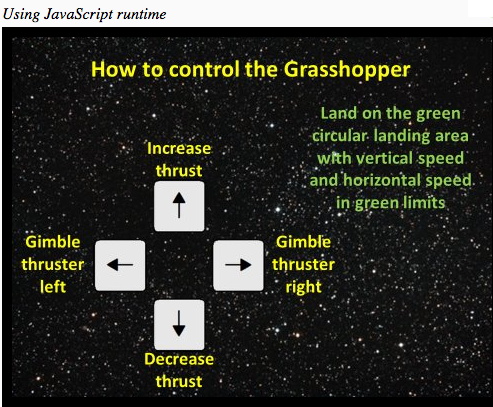
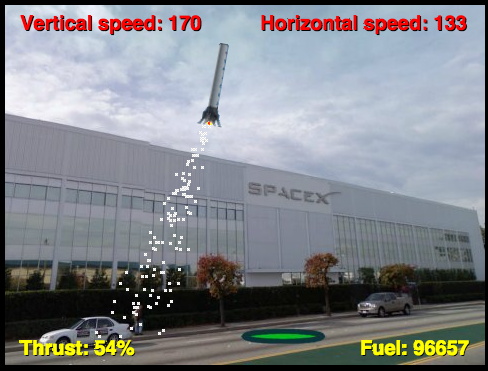
https://www.yousrc.com/index.asp?LEFTBUT=SHOWCASE&APPID=6638-9790&Action=Run&TOPBUT=SEARCH
You can get a bit of a feel for what it is like to try to accurately land safely using vectored thrust (in 2D). Try tilting it 15 degrees off vertical and then see how much trouble it is to stop the horizontal motion, come back, and land safely. Though this game is sluggish, and does not tilt a lot, so it is not as tricky to do as the older games were. And nowhere near as hard as doing it 3D in the real world.
Then realize how hard it would ever be to tilt 45 degrees or so, building up massive horizontal velocity, then try to tilt the other way to stop the horizontal momentum and then try to land accurately on a spot, with a vehicle never designed to be able to do that maneuver.
- George Gassaway


Last edited:
- Joined
- Jan 17, 2009
- Messages
- 5,204
- Reaction score
- 1,547
Ah, here's a Web based Lunar Lander that is a lot better:
https://phet.colorado.edu/sims/lunar-lander/lunar-lander_en.html
Much better controls, can rotate 360 degrees, and can display the velocity vector.
The last screenshot sort of represents the kind of tilt and velocity vector that the F9 booster seemed to have when it hit the barge.
- George Gassaway
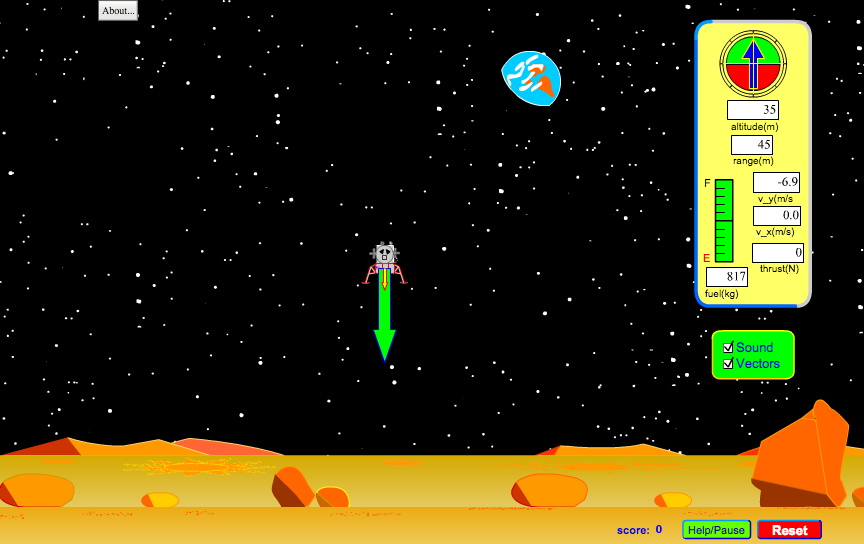
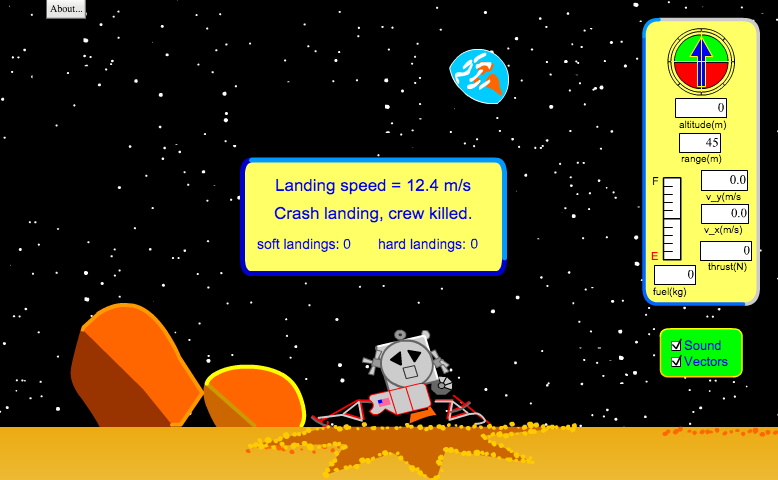
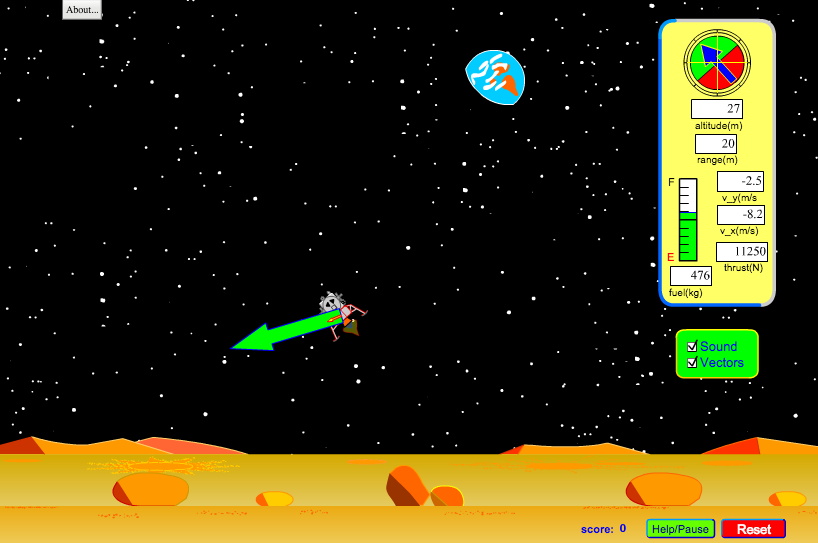
https://phet.colorado.edu/sims/lunar-lander/lunar-lander_en.html
Much better controls, can rotate 360 degrees, and can display the velocity vector.
The last screenshot sort of represents the kind of tilt and velocity vector that the F9 booster seemed to have when it hit the barge.
- George Gassaway



- Joined
- Jan 17, 2009
- Messages
- 5,204
- Reaction score
- 1,547
Yes, looks like that will be the next landing attempt. Won't be surprised if it slips into early February. Hope the launch window will be in daylight.I have just noticed the next launch has been moved from the 29th to the 31st
Ha! Some clever person made an animated GIF of the real video showing what the last moments and crash would look like with "Kerbal Space Program" flight data displays, including the "Game Over" Flight Results gray info box.
Can not get it to display in the message, so here is the link for the animated GIF:
https://www.gfycat.com/ExemplaryBeneficialAmericanlobster
Two screenshots below.
- George Gassaway
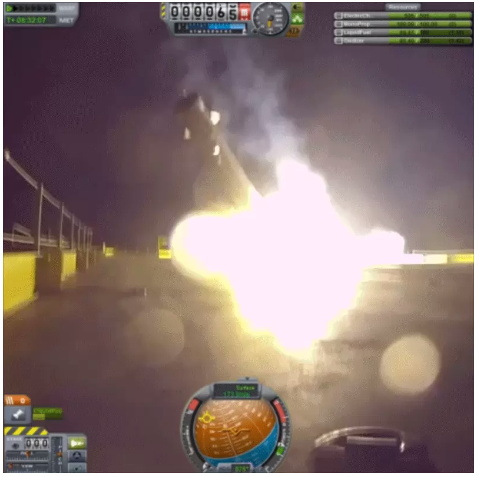
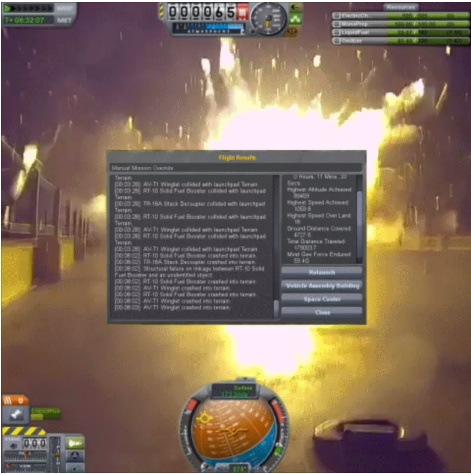
Last edited:
boatgeek
Well-Known Member
- Joined
- Dec 27, 2014
- Messages
- 7,404
- Reaction score
- 7,941
I think there was an Edison line something like "I haven't failed, I just haven't succeeded yet." I think that's a pretty good description. Seeing the video of that stage inbound, it's pretty surprising that there wasn't more damage to the barge. I guess it's not a fair fight between a barge made of 3/8" or 1/2" steel and a thin-wall aluminum rocket stage.
The fact that they were able to direct the booster stage back down to within feet of success, in the middle of the ocean, is a huge success!
- Joined
- Jan 14, 2009
- Messages
- 2,724
- Reaction score
- 352
An amazing feat. I'm looking forward to celebrating a completed landing n the near future.
- Joined
- Jan 17, 2009
- Messages
- 5,204
- Reaction score
- 1,547
Update - Next flight is now listed as Feb 9th (was Jan 31st). The DSCOVR satellite for NOAA.
Found on NSF forum, this image from SpaceX's Hawthorne Control Center during the last flight (picture was on NASA's Kennedy Space Center Facebook page, see link).
The person who posted it believes that there was live video from the barge (ASDS). The big screen to the upper right does seem to show the circles on the deck. The bright light is probably a floodlight and glare.
- George Gassaway
https://www.facebook.com/NASAKenned...86505458090/10152593864058091/?type=1&theater

Found on NSF forum, this image from SpaceX's Hawthorne Control Center during the last flight (picture was on NASA's Kennedy Space Center Facebook page, see link).
The person who posted it believes that there was live video from the barge (ASDS). The big screen to the upper right does seem to show the circles on the deck. The bright light is probably a floodlight and glare.
- George Gassaway
https://www.facebook.com/NASAKenned...86505458090/10152593864058091/?type=1&theater

Last edited:
jmattingly13
Well-Known Member
Update - Next flight is now listed as Feb 9th (was Jan 31st). The DSCOVR satellite for NOAA.
Found on NSF forum, this image from SpaceX's Hawthorne Control Center during the last flight (picture was on NASA's Kennedy Space Center Facebook page, see link).
The person who posted it believes that there was live video from the barge (ASDS). The big screen to the upper right does seem to show the circles on the deck. The bright light is probably a floodlight and glare.
- George Gassaway
https://www.facebook.com/NASAKenned...86505458090/10152593864058091/?type=1&theater

That's not the Hawthorne mission control. If I had to guess, it's probably their launch support center at the Cape.
- Joined
- Jan 17, 2009
- Messages
- 5,204
- Reaction score
- 1,547
That's not the Hawthorne mission control. If I had to guess, it's probably their launch support center at the Cape.
Thanks for the correction. The person who posted it on NSF said it was.
BTW - It has been said that there are two control rooms for the flights that fly reuseable stages. Main one for the primary mission, and one for the reuseable first stage landing, "down the hall" from the other. Which would make sense.
- George Gassaway
Last edited:
jmattingly13
Well-Known Member
Thanks for the correction. The person who posted it on NSF said it was.
BTW - It has been said that there are two control rooms for the flights that fly reuseable stages. Main one for the primary mission, and one for the reuseable first stage landing, "down the hall" from the other. Which would make sense.
- George Gassaway
Maybe you're right about that. It does make lots of sense given the timing of landing. I wasn't aware of a second control room down the hall. It certainly isn't the glass palace they constructed for the main mission control center.
Update - Next flight is now listed as Feb 9th (was Jan 31st). The DSCOVR satellite for NOAA.
Found on NSF forum, this image from SpaceX's Hawthorne Control Center during the last flight (picture was on NASA's Kennedy Space Center Facebook page, see link).
The person who posted it believes that there was live video from the barge (ASDS). The big screen to the upper right does seem to show the circles on the deck. The bright light is probably a floodlight and glare.
- George Gassaway
https://www.facebook.com/NASAKenned...86505458090/10152593864058091/?type=1&theater

The picture on the large screen certainly does appear to be on the barge landing area. It is hard to tell but it almost looks like a central perspective not the corner perspective or close to corner perspective of the released footage. I would find it hard to believe that there would only be one camera on that barge.
- Joined
- Jan 17, 2009
- Messages
- 5,204
- Reaction score
- 1,547
The picture on the large screen certainly does appear to be on the barge landing area. It is hard to tell but it almost looks like a central perspective not the corner perspective or close to corner perspective of the released footage. I would find it hard to believe that there would only be one camera on that barge.
Oh, for sure, several cameras. Go-Pro type cameras are cheap (for them) and easy enough to use several, if they did not use something more advanced than that.
I even expected they would use one or more R/C Multicopters (drone), taking off a few minutes before the landing and programmed to get into position for an ideal "sweet spot" view of the landing, such as seen in some of their McGregor test flight videos (I'm sure those were human-piloted, but it would be easy enough for a company like SpaceX to make them do this sort of thing, or whoever their "videodrone" specialists may be). And an earlier photo of the ASDS barge at sea was taken from the air, at night or almost darkness, which I highly suspect was by a drone. But if there was too much fog, maybe they didn't do the drones. Or maybe there is some even more impressive drone video that they have not released.
In any case, various cameras would be on the barge, taking video. But for the sake of trading off costs and complexity of live video transmission from the barge, they might only have had just that one, as one pointed at the whole deck would be all they needed live for the basic answer to the BIG question. Other camera footage could be retrieved later depending on however the data was stored (totally fixed like GoPro type cameras turned on and off, or remote video feeds to Tivo-like DVR's on the barge. So the likely only way they'd lose all the footage would be if the barge sank.... or a crashing rocket wiped out the DVR. Any drone footage I'd expect to be DVR'ed, or a least as a back-up in case the drone with a Go-Pro crashed...uh, sank. Actually, they''re smart enough to be sure a "splashed" drone would float. Though perhaps not worth retrieving, other than stored video, as most of it would be ruined by sea water).
- George Gassaway
Last edited:
- Joined
- Aug 18, 2011
- Messages
- 1,459
- Reaction score
- 57
[video=youtube;4Ca6x4QbpoM]https://www.youtube.com/watch?v=4Ca6x4QbpoM&feature=youtu.be[/video]
This may wet everyone's whistle.
This may wet everyone's whistle.
You beat me to it. This has some clues as to what SpaceX intends to do with the extra landing pad at the Cape.
- Joined
- Jul 23, 2012
- Messages
- 1,899
- Reaction score
- 873
Are they really building five landing pads at LC39? If so... can you say 'Falcon Ultra Heavy'?
ThirstyBarbarian
Well-Known Member
- Joined
- Feb 11, 2013
- Messages
- 12,249
- Reaction score
- 7,481
Good video! That was pretty cool. Hopefully they can pul it off.
ThirstyBarbarian
Well-Known Member
- Joined
- Feb 11, 2013
- Messages
- 12,249
- Reaction score
- 7,481
Are they really building five landing pads at LC39? If so... can you say 'Falcon Ultra Heavy'?
Mars Colonial Transporter...
jmattingly13
Well-Known Member
Mars Colonial Transporter...
I haven't seen any 5-core notional drawings for MCT (clarification: I really haven't seen any, though Wikipedia's imagination seems to limit itself to a single core or 3 parallel boosters for all SpaceX rockets), but I could believe 2 FH boosters + 1 FH stage 1 core + 1 FH stage 2 core + 1 seriously overweight Dragon.
ThirstyBarbarian
Well-Known Member
- Joined
- Feb 11, 2013
- Messages
- 12,249
- Reaction score
- 7,481
I haven't seen any 5-core notional drawings for MCT (clarification: I really haven't seen any, though Wikipedia's imagination seems to limit itself to a single core or 3 parallel boosters for all SpaceX rockets), but I could believe 2 FH boosters + 1 FH stage 1 core + 1 FH stage 2 core + 1 seriously overweight Dragon.
I havent seen any either. I was just throwing it out there for fun, not so much a real guess about the five landing pads. I can't wait to see more details about the MCT.
Similar threads
- Replies
- 5
- Views
- 611
- Replies
- 7
- Views
- 578
- Replies
- 29
- Views
- 2K
- Replies
- 6
- Views
- 2K



